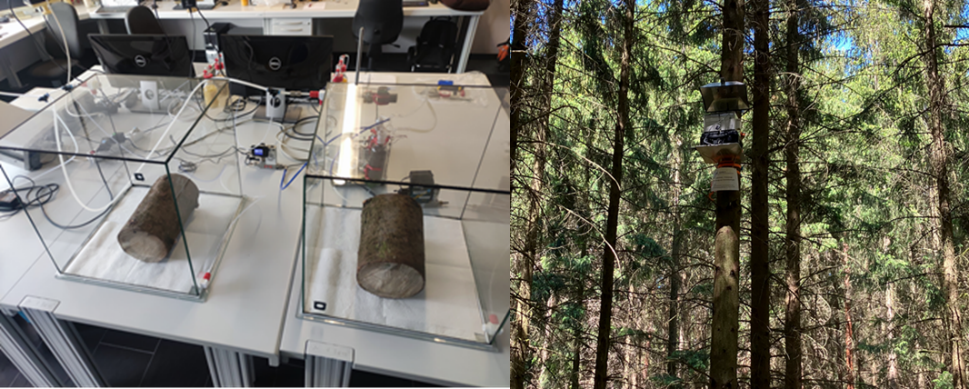
Forst View
Early detection of forest-damaging insects based on their species-specific volatiles using ion mobility spectrometry in preventive forest protection
Duration: 01/2023 – 12/2025
Funding: Federal Ministry of Food and Agriculture (BMEL) / Fachagentur für Nachwachsende Rohstoffe e.V. (FNR)

Partners:
- TU Dresden, Chair of Forest Protection
- TU Dresden, CIMTT Centre of Production Engineering and Management
- IFU GmbH Privates Institut für Analytik
The objective of the ForstView project is to develop and to test a modern and effective sensor technology using ion mobility spectrometry (IMS) for the early detection of forest-damaging insects, including the nun (Lymantria monacha L.), the pine moth (Dendrolimus pini L.), the oak processionary moth (Thaumatopoea processionea L.), and the European spruce bark beetle (Ips typographus L.). The sensor technology to be developed should enable the detection of infested trees or forest areas before damage and clear signs of infestation become apparent. In order to provide a valid measurement technique for the reliable early detection, the volatile substances emitted by the forest-damaging insects and host trees must be investigated and identified in laboratory and field tests.
In controlled laboratory experiments, the substances emitted by the target insects at different stages of development are analyzed using IMS and thermal desorption gas chromatography-mass spectrometry (TD-GC-MS). The aim is to identify specific markers for infestation with forest-damaging insects on the basis of measured IMS spectra and detected substance patterns.
In addition to the laboratory tests, extensive field tests are carried out at infested and non-infested forest sites. The aim of these tests is to optimize the measurement methods used so that the markers identified in the laboratory trials can also be detected under varying environmental conditions in the complex forest air matrix. This should ensure that the forest-damaging insects can also be detected reliably and at an early infestation stage under real environmental conditions.
In controlled laboratory experiments, the substances emitted by the target insects at different stages of development are analyzed using IMS and thermal desorption gas chromatography-mass spectrometry (TD-GC-MS). The aim is to identify specific markers for infestation with forest-damaging insects on the basis of measured IMS spectra and detected substance patterns.
In addition to the laboratory tests, extensive field tests are carried out at infested and non-infested forest sites. The aim of these tests is to optimize the measurement methods used so that the markers identified in the laboratory trials can also be detected under varying environmental conditions in the complex forest air matrix. This should ensure that the forest-damaging insects can also be detected reliably and at an early infestation stage under real environmental conditions.

Based on the laboratory and field tests, a hand-held IMS system is to be developed. This device should enable forestry workers to quickly and reliably detect infested trees or forest areas before visible signs of infestation appear. In conjunction with established monitoring methods, this should enable the timely restoration of affected stands in order to minimize the damage caused by the insects. The ForstView project thus makes an important contribution to forest protection and to maintaining the ecological and economic value of forests.
